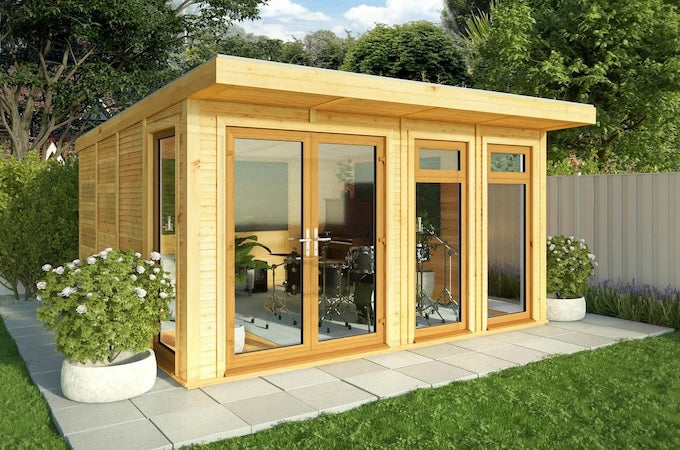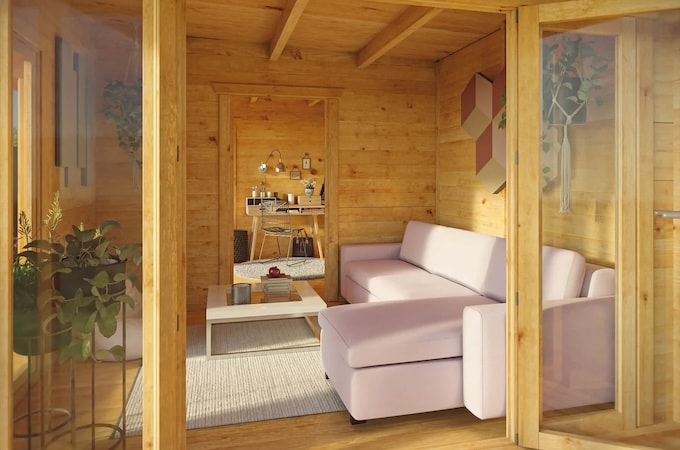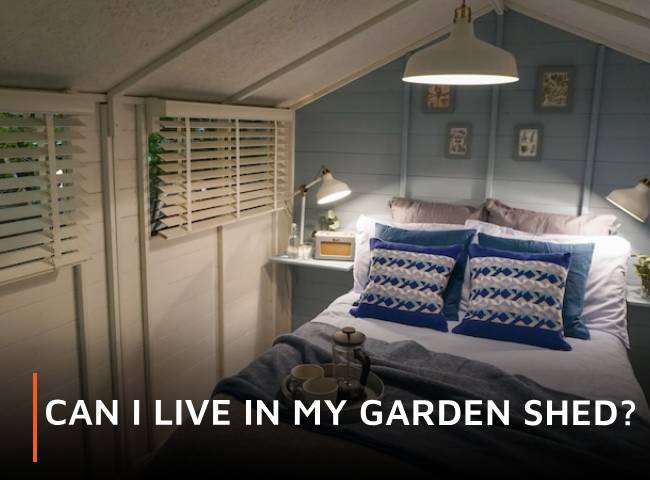Modern garden sheds are just as likely to be used as dedicated home offices, craft rooms or gyms as a tired tool store at the bottom of the garden.
The big question is, can you live in one?
The short answer is no, if you’re talking about a traditional garden shed. Any garden building that is to be used as a full time ‘granny annexe’ or regular sleeping accommodation requires planning permission and must meet current building regulations. The good news? With the appropriate modifications and adherence to building regulations, you can use your shed as an occasional extra bedroom. Here’s how.
Be clear about your shed’s intended use

Image: 4x4m Edwinstowe Premium Insulated Garden Room with oak UPVC from Waltons
Putting a sofa bed in your garden room that guests, children, or snoring partners might spend a rare night in is very different to setting up a proper bedroom that will be slept in regularly.
For occasional use, most people can construct a shed or garden room under permitted development rights (i.e. without applying for planning permission) and add a sofa bed for the odd guest.
However, your garden room must comply with Building Regulations if someone is going to sleep in it.
And for those who want to sleep regularly in their shed, or create more permanent self-contained accommodation, you must comply with Building Regulations AND apply for planning permission.
It’s important to understand that planning permission and Building Regulations are not the same thing.
Why it’s important to comply with building regulations

Image: Shutterstock
To sleep in a shed or garden room, it must comply with Building Regulations. These control the quality of the building’s structure, the materials used and ensure that it’s safe for sleeping in. Building regulations control the standards and safety of all living accommodation, including ancillary bedrooms in garage conversions or outbuildings.
In general, building regulations cover things like:
- Foundations and floor construction
- Structural stability
- Insulation, heating and double-glazing
- Electricity
- Plumbing and drainage
- Fire proofing
When you have completed the work to the correct standard, and it has been inspected by the relevant authority, you will receive a certificate. If in doubt, seek the advice of your local planning authority before you begin.
Do I need planning permission to live in a shed?

Image: 6x4m Premium Kingfisher Log Cabin from Waltons
To set your garden building up as a regularly used bedroom, or to create self-contained accommodation that can be lived in more permanently, you will need to apply for planning permission as well as comply with Building Regulations.
Before purchasing a log cabin, insulated garden room or summer house from Waltons, contact your local planning office for advice. Planning permission rules differ depending on where you live in the UK, but your local council’s duty Planning Officer will be happy to guide you through the process. Our guide to planning permission also contains more information.
Do I have to pay council tax to sleep in a shed?

Image: Shutterstock
If you create self-contained accommodation in your shed or outbuilding, bear in mind that you may be required to pay council tax. If the garden room is inhabited by a family member, under the ‘granny annexe council tax’ rules of 2014, you may be entitled to a 50% reduction or, in some cases, a full exemption. But do get in touch with your local council as it’s your responsibility to find out.
Living in your shed, log cabin or garden room requires contact with your local planning department but, with a little effort, it’s certainly possible. If you haven’t yet bought a garden building, check with your planning officer before you take the next step. They will be happy to help you achieve something that is safe and comfortable.
Lead image: Waltons



Share:
Shed maintenance - tips from the experts
How to choose the right shed: 5 tips from the experts